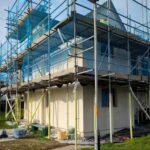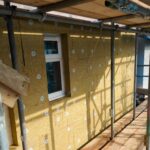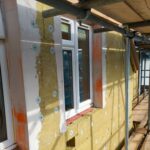In Retrofit by Robert Wheeler / 5 December 2023 / 0 comments

House retrofitting has gained significant attention in the United Kingdom as homeowners seek ways to improve energy efficiency, increase comfort & reduce their environmental impact. Retrofitting involves making modifications to existing homes to enhance their performance, such as upgrading insulation, improving heating systems & implementing renewable energy solutions.
However, before embarking on a retrofitting project, it is crucial to understand the associated costs and considerations. This blog post aims to provide valuable insights into the cost of retrofitting a house in the UK, exploring key factors influencing expenses, breakdown of costs, government schemes, case studies, and tips for budgeting. By delving into these aspects, homeowners can make informed decisions about retrofitting their properties while maximizing the benefits and minimizing financial implications.
Introduction to house retrofitting in the UK
What is house retrofitting?
House retrofitting refers to the process of making improvements or upgrades to an existing property in order to enhance its energy efficiency, comfort, and environmental sustainability. It involves various modifications, such as insulation installation, window replacements, and heating system upgrades.
Importance of retrofitting in the UK
Retrofitting is gaining popularity in the UK due to its numerous benefits. With the rising energy costs and increasing concerns about climate change, retrofitting plays a crucial role in reducing carbon emissions and achieving energy efficiency targets. It also helps homeowners save money on energy bills and improves the overall comfort and value of the property.
Understanding the purpose and benefits of retrofitting
Energy efficiency improvements
One of the primary goals of retrofitting is to improve the energy efficiency of a house. By implementing measures like insulation and double-glazing, homeowners can significantly reduce heat loss, resulting in lower energy consumption and reduced carbon footprint. This not only saves money but also helps in creating a greener and more sustainable environment.
Enhancing comfort and well-being
Retrofitting can greatly enhance the comfort and well-being of homeowners. Upgrades such as improving insulation, installing efficient heating systems, and replacing old windows can create a more pleasant living environment by reducing drafts, cold spots, and noise pollution. This can lead to improved indoor air quality and a healthier living space.
Environmental sustainability
In the fight against climate change, retrofitting plays a crucial role. By reducing energy consumption and carbon emissions, retrofitting contributes to a more sustainable future. It helps in the conservation of natural resources and promotes a healthier planet for future generations.
Key factors influencing the cost of house retrofitting
Size and condition of the property
The size and condition of the property are crucial factors that influence the cost of retrofitting. Larger properties will require more materials and labour, resulting in higher expenses. Similarly, the condition of the property can affect the complexity of the retrofitting work and additional repairs that may be needed, impacting the overall cost.
Scope of retrofitting work
The scope of retrofitting work also plays a significant role in determining the cost. More extensive projects that involve multiple upgrades, such as insulation, heating system replacements, and window upgrades, will naturally incur higher expenses compared to smaller-scale retrofits.
Complexity of the retrofitting project
The complexity of the retrofitting project can impact the cost due to the additional expertise and labor required. Projects that involve structural changes or intricate installations may require specialized professionals, which can increase the overall expenses.
Breakdown of expenses: materials, labor, and professional services
Cost of retrofitting materials
Materials such as insulation, windows, and heating systems can vary in cost depending on the quality and specifications. Higher-quality materials may initially incur higher expenses but can provide better long-term savings. It is essential to consider the energy efficiency and durability of materials when estimating retrofitting costs.
Labour costs for retrofitting work
Labour costs are a significant part of retrofitting expenses. The complexity and duration of the project will determine the amount of labour required. Hiring skilled professionals may come with a higher price tag, but it ensures quality workmanship and minimizes the risk of costly mistakes.
Professional services and consultations
Seeking professional services and consultations during the retrofitting process can be beneficial, particularly for complex projects. Architects, engineers, and energy assessors can provide valuable insights and advice. However, it’s important to consider the associated costs when budgeting for retrofitting.
Remember, retrofitting your house is an investment that can bring long-term benefits. While the cost may seem daunting, the potential energy savings, increased comfort, and environmental impact make it a worthwhile endeavour. So, buckle up and give your house the retrofitting it deserves!
Government schemes and financial support for house retrofitting
Overview of available government schemes
Retrofitting your house may sound like an expensive endeavour, but fear not! The UK government offers several schemes to help ease the financial burden. These schemes are aimed at reducing carbon emissions and increasing energy efficiency in homes across the country.
Grants and funding options for retrofit projects
When it comes to funding your retrofit project, there are a few options to explore. The Green Homes Grant, for example, provides vouchers worth up to £5,000 (or £10,000 for low-income households) to help cover the costs of energy-saving measures. Additionally, there are various local authority grants and funding options available, so it’s worth checking with your local council to see what’s on offer. Remember, every little bit helps when it comes to financing your retrofit dreams!
Case studies: Cost ranges for different types of retrofit projects
Insulation retrofitting costs
Insulation is often the first step in retrofitting your home, and it can have a significant impact on reducing energy consumption. On average, insulating your loft can cost anywhere from £300 to £1,000, depending on the size of your house. External wall insulation can range from £8,000 to £16,000, while cavity wall insulation may set you back between £500 and £1,500. Remember, these figures are just ballpark estimates and can vary depending on several factors such as the materials used and the complexity of the installation.
Heating system upgrades and costs
Upgrading your heating system to a more efficient one can lead to long-term savings on your energy bills. Costs will vary depending on the type of system you choose. For instance, a new gas boiler installation can range from £1,500 to £3,000, while installing an air source heat pump can set you back between £7,000 and £13,000. It’s important to consider the potential savings in energy costs when deciding on the right heating system for your home.
Window and door replacements and costs
Replacing old, draughty windows and doors can improve both the comfort and energy efficiency of your home. Prices for double glazing windows can range from £3,000 to £8,000, depending on the size and number of windows required. Similarly, the cost of replacing external doors can vary from £500 to £1,500. It’s worth exploring different suppliers and materials to find the best value for your money.
Tips for budgeting and managing the costs of house retrofitting
Conducting a comprehensive cost analysis
Before diving into your retrofitting project, take the time to conduct a comprehensive cost analysis. Research the average prices for materials, labour, and any additional expenses that may arise. Having a clear understanding of the potential costs will help you set a realistic budget.
Prioritizing retrofitting measures
When retrofitting your house, it’s essential to prioritize the most critical measures that will have the biggest impact on energy efficiency. Focus on insulation, heating system upgrades, and draft-proofing, as these tend to offer the most significant savings in the long run. You can always tackle other projects later when your budget allows.
Seeking multiple quotes and professional advice
Don’t be afraid to shop around and seek multiple quotes from different contractors. This will help you compare prices and ensure you get the best value for your money. It’s also a good idea to consult with professionals who specialize in retrofitting to get expert advice and guidance throughout the process.
Conclusion: Making informed decisions about retrofitting your house in the UK
As the demand for energy-efficient and sustainable homes continues to grow, retrofitting offers homeowners in the UK an opportunity to upgrade their properties. By understanding the factors that influence the cost of retrofitting, breaking down expenses, exploring government schemes, and learning from case studies, individuals can make informed decisions about their retrofit projects.
With careful budgeting and the assistance of professionals, homeowners can transform their houses into more energy-efficient and comfortable spaces, contributing to a greener future while potentially saving on long-term energy costs.
Embracing retrofitting not only benefits the environment but also enhances the overall value and liveability of a home. So, whether it’s insulation improvements, heating system upgrades, or window replacements, retrofitting presents a worthwhile investment for a sustainable and comfortable future.
Retrofit A Home FAQs
Factors such as the size and condition of the property, the scope of retrofitting work, and the complexity of the project can all impact the cost of house retrofitting in the UK. These factors can vary from one project to another and should be carefully assessed before estimating the overall expenses.
Yes, the UK government provides various schemes and financial support options to encourage house retrofitting. These include grants, subsidies, and loans aimed at helping homeowners reduce the upfront costs of retrofit projects and make energy-efficient upgrades more accessible.
The amount homeowners can save on energy costs after retrofitting their houses in the UK depends on several factors, including the specific retrofit measures implemented, the energy consumption patterns, and the efficiency of the existing systems. While estimates vary, it is not uncommon for homeowners to achieve substantial energy savings ranging from 20% to 40% or more.
Yes, retrofitting your house in stages is a common approach for managing costs. By prioritizing the most critical retrofit measures first and spreading out the expenses over time, homeowners can gradually improve the energy efficiency and comfort of their homes without undertaking a full-scale retrofit all at once.
Ready to discuss your regeneration project and how NXTGEN Futures Ltd can elevate it with expert retrofit? Contact us today!
Latest Retrofit Posts
- What a retrofit-first approach offers the UKRetrofitting is like giving your home a makeover to make it more energy-efficient, comfortable, and healthy. The retrofit-first approach prioritizes upgrading existing buildings over new construction to tackle climate change and improve living conditions. Definition of Retrofitting Retrofitting involves making… Read more: What a retrofit-first approach offers the UK
- What is internal wall insulation?Internal wall insulation is a crucial component of creating a comfortable and energy-efficient living space. By insulating the walls within a building, homeowners can experience benefits such as improved thermal performance, reduced energy bills, and enhanced acoustic comfort. Understanding the… Read more: What is internal wall insulation?
- What is a retrofit assessor?Retrofit assessors play a crucial role in the sustainability and energy efficiency of buildings by evaluating and identifying opportunities for improvement. This blog post aims to provide an in-depth understanding of the responsibilities, qualifications, and benefits associated with being a… Read more: What is a retrofit assessor?
- What is a retrofit assessment in the UK?Retrofit assessments play a crucial role in the sustainable development of buildings in the UK, helping to improve energy efficiency, reduce carbon emissions, and enhance overall building performance. By evaluating existing structures and identifying opportunities for upgrades and enhancements, retrofit… Read more: What is a retrofit assessment in the UK?
- Retrofit and Energy Efficiency in Historic BuildingsHistoric buildings are not only architectural treasures but also valuable cultural assets that contribute to our sense of history and identity. However, many of these buildings often suffer from poor energy efficiency, leading to excessive energy consumption and high operating… Read more: Retrofit and Energy Efficiency in Historic Buildings
- What is retrofitting in construction?Retrofitting in construction is a crucial process that involves upgrading existing buildings or structures to meet modern standards of safety, energy efficiency, and functionality. This blog post explores the concept of retrofitting, its importance, various techniques used in the industry,… Read more: What is retrofitting in construction?
- CASE STUDY: Curtis WayDelivering a Holistic Retrofit Solution with EWI & Solar Energy Project Overview NXTGEN Futures Ltd. successfully completed a large-scale retrofit project on Curtis Way, Berkhamsted, England, UK. This case study showcases our expertise in External Wall Insulation (EWI), retrofit coordination,… Read more: CASE STUDY: Curtis Way
- What happens to a building during retrofitting?Building retrofitting is a vital process that involves making significant modifications and improvements to existing structures to enhance their efficiency, functionality, and sustainability. In this blog post, we will delve into the intricate workings of building retrofitting, exploring the various… Read more: What happens to a building during retrofitting?
- UK Government Retrofit Scheme: Making Energy Efficiency Cool AgainIntroduction to the UK Government Retrofit Scheme Background of the Retrofit Scheme Picture this: you’re sitting at home, snuggled up in your favourite blanket, enjoying a cup of tea, when suddenly you feel a draft. Not cool, right? Well, that’s… Read more: UK Government Retrofit Scheme: Making Energy Efficiency Cool Again
- What are Retrofit Trickle Vents?Improving indoor air quality and enhancing energy efficiency are key priorities for many homeowners. In this article, we will explore the concept of retrofit trickle vents and their role in achieving these goals. Trickle vents are small, adjustable openings integrated… Read more: What are Retrofit Trickle Vents?
- Retrofit Underfloor HeatingRetrofit underfloor heating has gained significant popularity as a cost-effective and efficient solution for enhancing the comfort and energy efficiency of existing buildings. Unlike traditional radiator systems, underfloor heating distributes warmth evenly across the floor, providing a comfortable and cozy… Read more: Retrofit Underfloor Heating
- Retrofit LondonRetrofitting has emerged as a crucial solution in transforming the landscape of cities, and London is no exception. As a global hub of culture, commerce, and innovation, London faces the pressing challenge of reducing its carbon footprint while ensuring sustainable… Read more: Retrofit London












